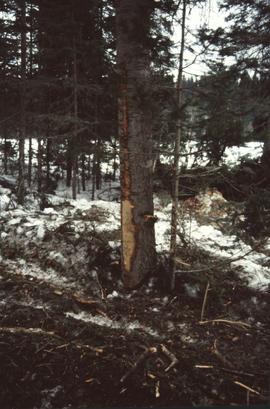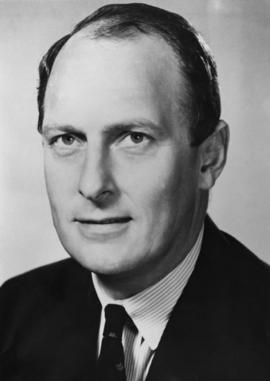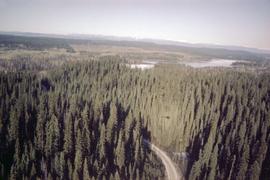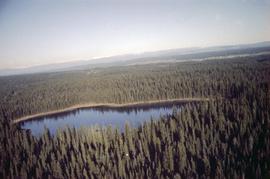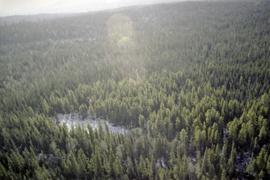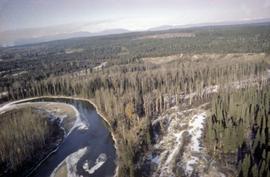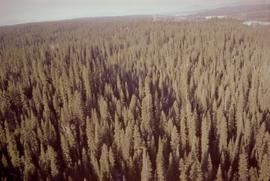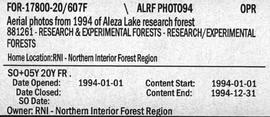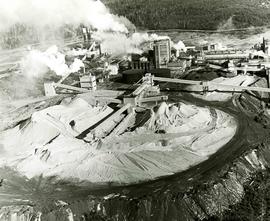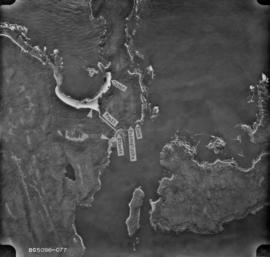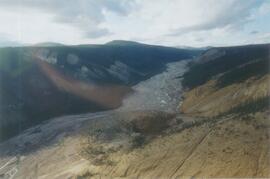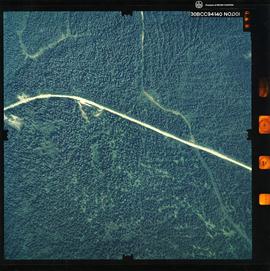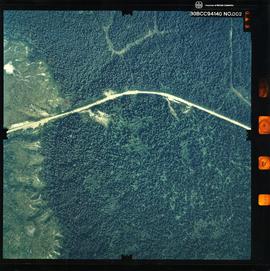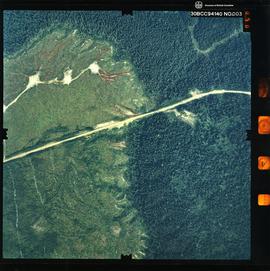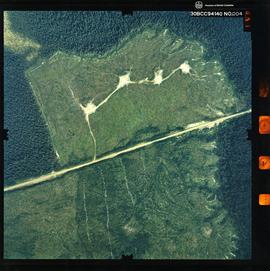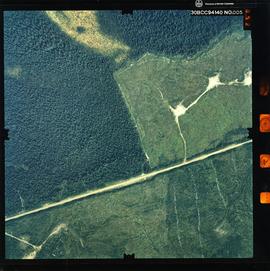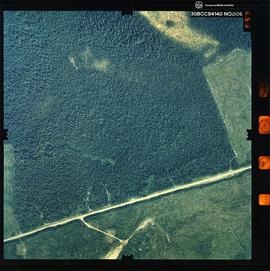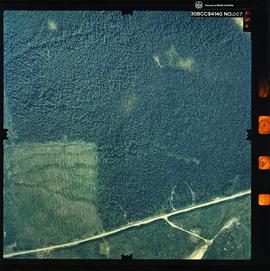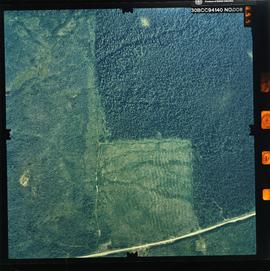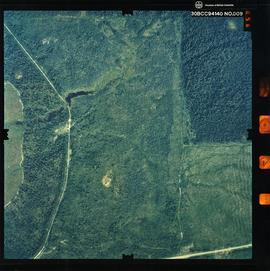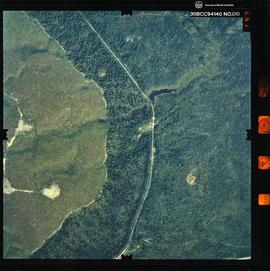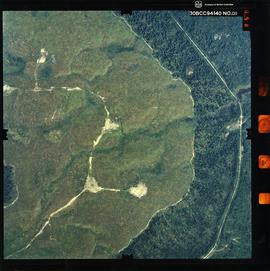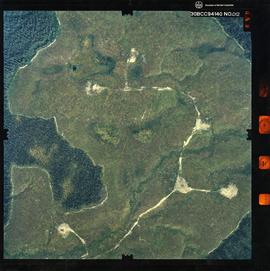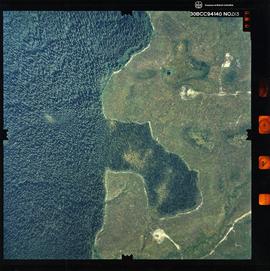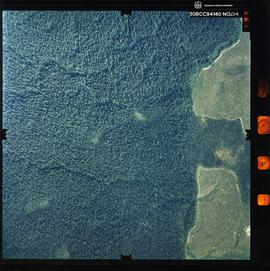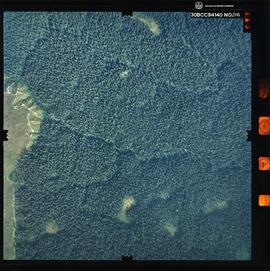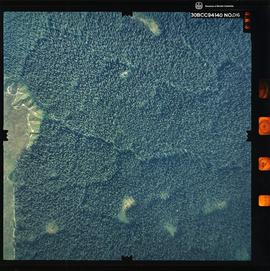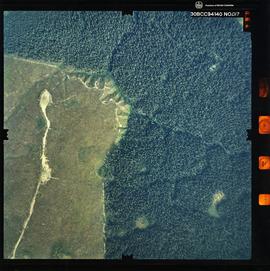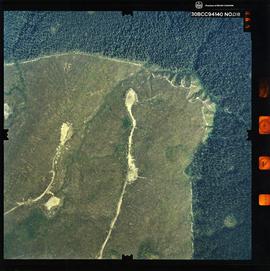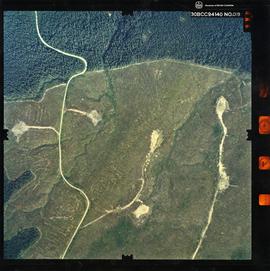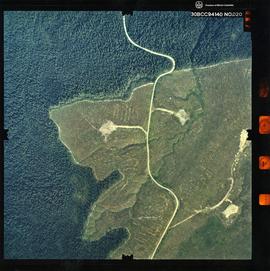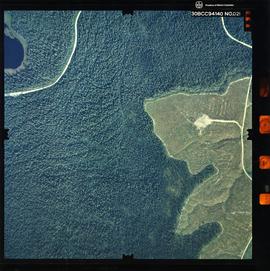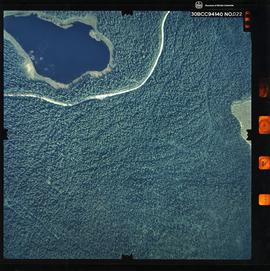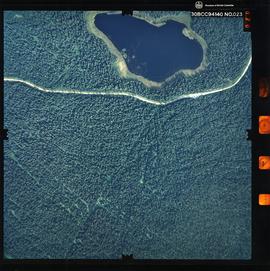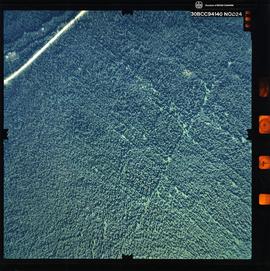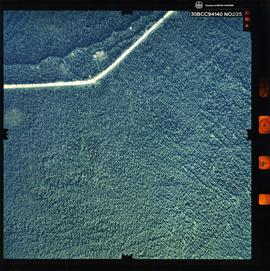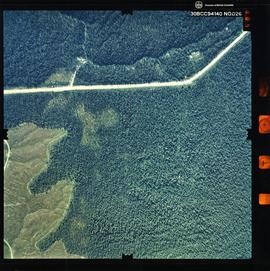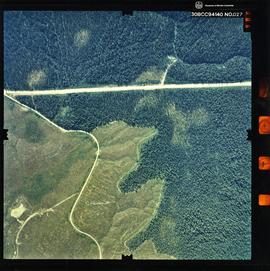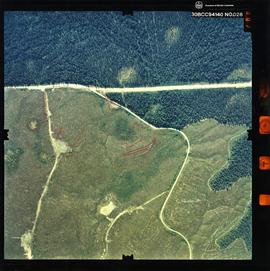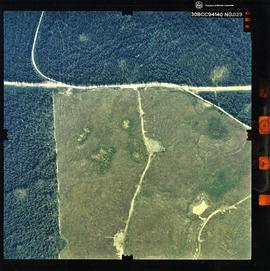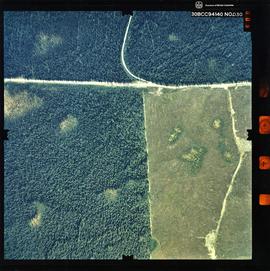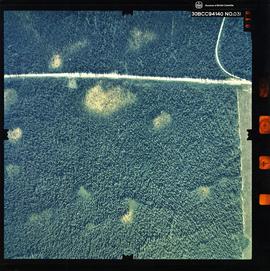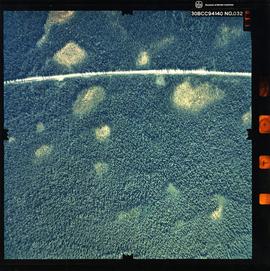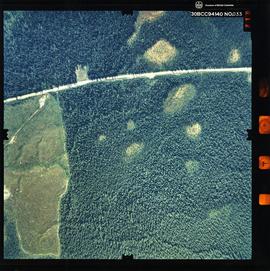No annotation provided on slide.
Annotation on slide: "Summit Lake, Light Abrasion".
This fonds consits of the administrative and business papers of Mr. Adam Zimmerman during his tenure as a senior level executive with Noranda Inc., Noranda Mines Ltd, and Macmillan Bloedel Ltd., particularly in Ontario, Quebec, and British Columbia with the majority of these records relating to the senior level operations of these companies. It includes textual records relate to the creation and development of Northwood Pulp & Timber Ltd. in Prince George including all aspects of its regional operations throughout Northcentral BC). The fonds also includes records related to Noranda Inc.’s successful and unsuccessful attempts at business acquisitions in both forestry and mining operations internationally, particularly in Mexico, Brazil, the Netherlands and Tasmania.
The fonds also contains textual records generated by Zimmerman in his directorship and chairman positions on various forest industry association boards. It includes his notes, general correspondence, minutes, as well as booklets and brochures notably from the Canadian Forest Industries Council, the Canadian Pulp and Paper Association, the Forest Sector Advisory Council and other similar industry associations. Much of this material relates to the issue of the softwood lumber dispute and Zimmerman’s involvement in the lobbying efforts regarding Canada/U.S. Free Trade issues and includes bound reports, agreements, and publications as well as correspondence to/from Zimmerman and his handwritten notes within the files. The fonds also includes general business information (annual reports, brochures, publications) pertaining to other Canadian forestry and mining companies.
The fonds also contains Adam Zimmerman’s speeches and correspondence related to his involvement in numerous charities, foundations and corporate fundraising initiatives with numerous Canadian educational institutions, non-profit societies and federal election campaigns.
Business records of Noranda Inc. are extensive and include administrative, business, personnel, financial and legal records. Record types include correspondence, memos, handwritten notes, business proposals and meeting notes, merger proposals and notes, prospectuses, board meeting agendas and minutes, annual reports, financial statements, resumes, portfolios, printed brochures, publications and other ephemera related to the business operations of Noranda Inc., Noranda Mines and MacMillan Bloedel [during Noranda Mines take-over of MB] all during Zimmerman’s tenure as Chair and/or CEO. The fonds includes correspondence, financial reports, legal testimony transcripts resulting from the Gaspe Copper Mine labour strike in Quebec in 1957 and the subsequent Gaspe Law Suit of 1960 between Noranda and the United Steel Workers of America. The fonds also includes extensive correspondence between Zimmerman and various levels of government regarding the lobbying of government on forestry policy and correspondence with various environmental lobbying groups in the 1980s including correspondence with well-known environmentalist David Suzuki.
Subjects include all facets of business operations pertaining to Canadian forestry and mining sectors including labour issues, environmental impacts of industrial developments, industry and effects on the Canadian economy, the free trade debate, the softwood lumber issue etc.
The fonds provides a detailed archival record of Mr. Zimmerman’s contribution to the building of Noranda Forest in Canada, Northwood Pulp & Timber in BC and Noranda Inc. as a resource-based conglomerate. Many records were utilized by Mr. Zimmerman in the writing of his book, Who’s in Charge Here, Anyway?: reflections from a life in business, (Don Mills, Ontario: Stoddart; Distributed in Canada by General Distribution Services), 1997.
Zimmerman, AdamAnnotation on slide: "BC[?] advance regen. releasing in logged cedar block, ICHwk3"
Photograph shows an aerial view of Aleza Lake Research Forest in spring season.
Photograph shows an aerial view of Aleza Lake Research Forest in spring season.
Photograph shows an aerial view of Aleza Lake Research Forest in spring season.
Photograph shows an aerial view of Aleza Lake Research Forest in spring season.
Photograph shows an aerial view of Aleza Lake Research Forest in spring season.
File contains colour aerial photography of the Aleza Lake Research Forest from 1994.
Attached description: This aerial view of the chip distribution system shows the network of enclosed conveyors which distribute different species of chips to individual piles. Reclaim-pits under these piles pick up chips for transporting to the two Kamyr continuous digesters. The building in the lower right of the picture is the main structure, housing the transfers and screening with the operators on the top floor. A blower system is used to carry chips from the existing Woodroom No. 1 to the piles. In the background, the sulphite and kraft pulping groups of Columbia Cellulose and Skeena Kraft are shown.
Attached description: Both the Columbia Cellulose Sulphite mill and the Skeena Kraft mill are shown in this aerial view. Woodroom No. 2 is shown at the left, and the main buildings of the sulphite mill in center. The right centre area of the picture shows the new 750 t/d Skeena Kraft mill. Skeena Kraft is the largest single-line pulp mill in operation in the world. In the foreground is the fishing village of Port Edward. The Integration of chip manufacturing and power plants provides the mills with common service facilities. Watson Island is approximately 11 miles from the city of Prince Rupert, which now has a population of about 17,000 people.
No annotation on slide.
Photograph depicts an aerial view of the Haida Gwaii shoreline near Kiusta.
Attached description: The thriving city of Prince Rupert is shown in this aerial picture. Prince Rupert has been enjoying a construction boom which includes the construction of the $80 million Skeena Kraft mill, hundreds of single-family homes, and hundreds of units in apartments, motels, and hotels. The construction of Skeena Kraft provided the stimulus for a population expansion to over 17,000. The Columbia Cellulose and Skeen a Kraft payrolls account for well over a third of the incomes of the city. Prince Rupert is, along with Terrace, the hub of a new economic region encompassing the Nass and Skeena valley regions.
During the 1980s, Agriculture Canada pedologists Scott Smith (retired from Summerland Research Station, formerly based in Whitehorse) and Charles Tarnocai (retired from Central Experimental Farm, Ottawa) had a large field program which addressed the trends in soil development in the central Yukon. Across this region, particularly between Whitehorse and Dawson City, the land surfaces and surficial deposits vary greatly in age due to the differing extents of glaciations over the past ~2 million years.
This work built on a pioneering study from the previous decade:
Foscolos, A.E., N.W. Rutter, and O.L. Hughes. 1977. The use of pedological studies in interpreting the Quaternary history of central Yukon Territory. Bulletin 271. Geological Survey of Canada, Ottawa. 48 p. https://doi.org/10.4095/103066
Tarnocai and Smith presented their results in two publications:
C. A. S. Smith, C. Tarnocai, and O. L. Hughes. 1986. Pedological investigations of Pleistocene glacial drift surfaces in the central Yukon. Géographie physique et Quaternaire, 40 (1): 29–37. https://doi.org/10.7202/032620ar
Tarnocai, C. and C. A. S. Smith. 1989. Micromorphology and development of some central Yukon paleosols, Canada. Geoderma 45 (2): 145-162. https://doi.org/10.1016/0016-7061(89)90047-5
Tarnocai and Smith shared the unpublished data and soil samples from this work with Dr. Paul Sanborn, and this resulted in a student project published as:
Daviel, E., P. Sanborn, C. Tarnocai, and C.A.A. Smith. 2011.Clay mineralogy and chemical properties of argillic horizons in central Yukon paleosols. Canadian Journal of Soil Science 91: 83-93. https://doi.org/10.4141/cjss10067
Photograph is a remote-sensing image of the Aleza Lake Research Forest from 1994.
Photograph is a remote-sensing image of the Aleza Lake Research Forest from 1994.
Photograph is a remote-sensing image of the Aleza Lake Research Forest from 1994.
Photograph is a remote-sensing image of the Aleza Lake Research Forest from 1994.
Photograph is a remote-sensing image of the Aleza Lake Research Forest from 1994.
Photograph is a remote-sensing image of the Aleza Lake Research Forest from 1994.
Photograph is a remote-sensing image of the Aleza Lake Research Forest from 1994.
Photograph is a remote-sensing image of the Aleza Lake Research Forest from 1994.
Photograph is a remote-sensing image of the Aleza Lake Research Forest from 1994.
Photograph is a remote-sensing image of the Aleza Lake Research Forest from 1994.
Photograph is a remote-sensing image of the Aleza Lake Research Forest from 1994.
Photograph is a remote-sensing image of the Aleza Lake Research Forest from 1994.
Photograph is a remote-sensing image of the Aleza Lake Research Forest from 1994.
Photograph is a remote-sensing image of the Aleza Lake Research Forest from 1994.
Photograph is a remote-sensing image of the Aleza Lake Research Forest from 1994.
Photograph is a remote-sensing image of the Aleza Lake Research Forest from 1994.
Photograph is a remote-sensing image of the Aleza Lake Research Forest from 1994.
Photograph is a remote-sensing image of the Aleza Lake Research Forest from 1994.
Photograph is a remote-sensing image of the Aleza Lake Research Forest from 1994.
Photograph is a remote-sensing image of the Aleza Lake Research Forest from 1994.
Photograph is a remote-sensing image of the Aleza Lake Research Forest from 1994.
Photograph is a remote-sensing image of the Aleza Lake Research Forest from 1994.
Photograph is a remote-sensing image of the Aleza Lake Research Forest from 1994.
Photograph is a remote-sensing image of the Aleza Lake Research Forest from 1994.
Photograph is a remote-sensing image of the Aleza Lake Research Forest from 1994.
Photograph is a remote-sensing image of the Aleza Lake Research Forest from 1994.
Photograph is a remote-sensing image of the Aleza Lake Research Forest from 1994.
Photograph is a remote-sensing image of the Aleza Lake Research Forest from 1994.
Photograph is a remote-sensing image of the Aleza Lake Research Forest from 1994.
Photograph is a remote-sensing image of the Aleza Lake Research Forest from 1994.
Photograph is a remote-sensing image of the Aleza Lake Research Forest from 1994.
Photograph is a remote-sensing image of the Aleza Lake Research Forest from 1994.
Photograph is a remote-sensing image of the Aleza Lake Research Forest from 1994.
